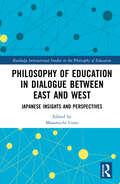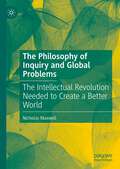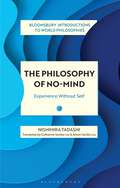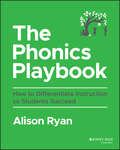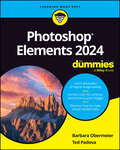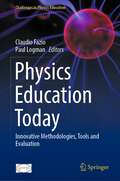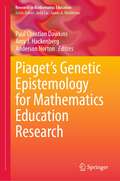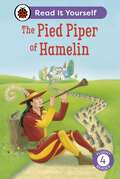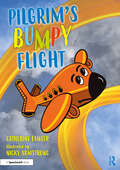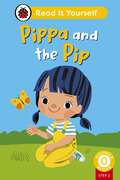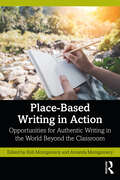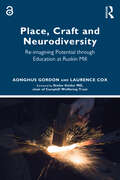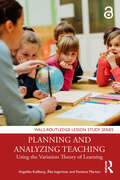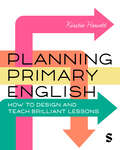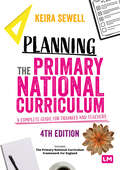- Table View
- List View
Philosophy of Education in Dialogue between East and West: Japanese Insights and Perspectives (Routledge International Studies in the Philosophy of Education)
by Masamichi UenoThis edited book opens a dialogue on theories and philosophies of education between the East and the West in the era of globalisation. A great deal of research has been devoted to discussion of the ideas of Western theorists such as Plato, Aristotle, Locke, Rousseau, Kant, Fröbel, Herbert, Dewey, Piaget, and so on, and their thoughts have had a tremendous impact on Japanese educational practices. In addition, the 21st-century society has promoted international academic standardisation of knowledge, skills, and competencies for a knowledge-based economy, making great strides in educational development for globalisation. On the other hand, East Asia has retained its own unique insights and perspectives that cannot entirely be understood by Western philosophies of education alone. The contributors to this volume offer the reader insights into how Japanese and East Asian theories and philosophies of education encounter those from the West, by taking up heated and controversial issues such as education of caring, morality, nature, catastrophe, body and cultivation, art, language, politics, democracy, and modernity. The book will appeal to researchers, teachers, students, policymakers, and anyone interested in the theory and philosophy of education in the East, or those who would like to reconsider education in a multicultural society.
Philosophy of Education in Dialogue between East and West: Japanese Insights and Perspectives (Routledge International Studies in the Philosophy of Education)
by Masamichi UenoThis edited book opens a dialogue on theories and philosophies of education between the East and the West in the era of globalisation. A great deal of research has been devoted to discussion of the ideas of Western theorists such as Plato, Aristotle, Locke, Rousseau, Kant, Fröbel, Herbert, Dewey, Piaget, and so on, and their thoughts have had a tremendous impact on Japanese educational practices. In addition, the 21st-century society has promoted international academic standardisation of knowledge, skills, and competencies for a knowledge-based economy, making great strides in educational development for globalisation. On the other hand, East Asia has retained its own unique insights and perspectives that cannot entirely be understood by Western philosophies of education alone. The contributors to this volume offer the reader insights into how Japanese and East Asian theories and philosophies of education encounter those from the West, by taking up heated and controversial issues such as education of caring, morality, nature, catastrophe, body and cultivation, art, language, politics, democracy, and modernity. The book will appeal to researchers, teachers, students, policymakers, and anyone interested in the theory and philosophy of education in the East, or those who would like to reconsider education in a multicultural society.
The Philosophy of Inquiry and Global Problems: The Intellectual Revolution Needed To Create A Better World
by Nicholas MaxwellThe Philosophy of No-Mind: Experience Without Self (Bloomsbury Introductions to World Philosophies)
by Nishihira TadashiNishihira Tadashi, one of Japan's leading philosophers, introduces the deeply experiential philosophy of no-mind (mushin). In everyday Japanese, mushin is when one loses oneself in the reality of the present and becomes one with it, resulting in one's best performance. However, behind this everyday use is a concept that touches the core of Japanese spirituality. This book explores no-mind in its dynamic complexity. It is both the letting go of the calculations of mind and at the same time the arising of a vibrant consciousness in unity with reality. This gives rise to various tensions: Is it about negating or affirming self? Is stillness or activity? How does it relate with social ethics, or religious transcendence? And what is stopping no-mind from descending into mere mindlessness? These tensional facets are explored through philosophy and history of thought in Japan, from pre-Buddhist Japanese thought, to Zen Buddhism in D.T. Suzuki and Toshihiko Izutsu, to swordsmanship and Noh theater. These historical approaches are brought to the here-and-now, dialoguing with psychology, ethics, and the experiences of everyday life, and ending with two preliminary practical explorations-What does it mean to care for another and to educate from the point of view of no-mind?
The Phonics Playbook: How to Differentiate Instruction So Students Succeed
by Alison RyanA guide for K-3 educators who need to teach phonics at different levels in diverse classrooms—without burning out The Phonics Playbook is the one phonics-focused resource that offers a solution for phonics instruction in real-world K-3 classrooms. Understanding phonics instruction in theory is one thing, but actually integrating it into daily classroom life—in a way that meets the needs of diverse students—is another. This book offers simplified instruction and practical guidance for differentiating instruction using three models: whole group instruction with elements of differentiation, phonics-focused small group instruction, and small group reading instruction that also incorporates phonics. You will learn to assess student needs, choose the model that’s right for you, and make data-based adjustments as time goes on. In addition to guidance on differentiation, this book also weaves in best practices in phonics instruction and effective strategies for teaching phonics skills, which is especially helpful for newer teachers. The Phonics Playbook guides you from start to finish and helps you develop a positive, effective mindset around differentiation. Confront the problem of “so many needs and so little time” in a productive, sustainable way and avoid burnout with this excellent guide. Review the basics of phonics instruction and learn three different methods for differentiating instruction in K-3 classrooms Help students progress with their reading, even when you have many different reading levels in class Reduce the workload necessary to provide differentiated instruction in phonics and reading Find practical ways of implementing phonics instruction in real-world classrooms with real-world challengesNew and experienced K-3 educators, principals, and literacy coaches, as well as homeschool educators and parents, will appreciate the no-nonsense approach in The Phonics Playbook.
The Phonics Playbook: How to Differentiate Instruction So Students Succeed
by Alison RyanA guide for K-3 educators who need to teach phonics at different levels in diverse classrooms—without burning out The Phonics Playbook is the one phonics-focused resource that offers a solution for phonics instruction in real-world K-3 classrooms. Understanding phonics instruction in theory is one thing, but actually integrating it into daily classroom life—in a way that meets the needs of diverse students—is another. This book offers simplified instruction and practical guidance for differentiating instruction using three models: whole group instruction with elements of differentiation, phonics-focused small group instruction, and small group reading instruction that also incorporates phonics. You will learn to assess student needs, choose the model that’s right for you, and make data-based adjustments as time goes on. In addition to guidance on differentiation, this book also weaves in best practices in phonics instruction and effective strategies for teaching phonics skills, which is especially helpful for newer teachers. The Phonics Playbook guides you from start to finish and helps you develop a positive, effective mindset around differentiation. Confront the problem of “so many needs and so little time” in a productive, sustainable way and avoid burnout with this excellent guide. Review the basics of phonics instruction and learn three different methods for differentiating instruction in K-3 classrooms Help students progress with their reading, even when you have many different reading levels in class Reduce the workload necessary to provide differentiated instruction in phonics and reading Find practical ways of implementing phonics instruction in real-world classrooms with real-world challengesNew and experienced K-3 educators, principals, and literacy coaches, as well as homeschool educators and parents, will appreciate the no-nonsense approach in The Phonics Playbook.
Photoshop Elements 2024 For Dummies
by Barbara Obermeier Ted PadovaGet in touch with your creative side using Photoshop Elements Photoshop Elements 2024 For Dummies covers the newest version of Adobe’s beginner-friendly photo editing software. With the help of this Dummies guide, you’ll discover the ins and outs of Photoshop Elements, so you can transform your images from ordinary to extraordinary. The software is packed with all the photo editing tools you need to turn your images into showstoppers. With the help of the easy-to-understand instructions in this book, you’ll learn how to use the editing tools, utilize layers, make one-click fixes, brighten colors, add filters, and beyond. Get started with Photoshop Elements and make basic edits in quick mode Create different views of an image and use the history panel to find the best version of your image Replace backgrounds, merge photos, and do other neat editing tricks Understand camera raw to turn your camera’s image data into a stunning photo This bestselling Dummies guide is the book you need to get started with Elements and learn the insider tips that will give your images that “wow factor.”
Photoshop Elements 2024 For Dummies
by Barbara Obermeier Ted PadovaGet in touch with your creative side using Photoshop Elements Photoshop Elements 2024 For Dummies covers the newest version of Adobe’s beginner-friendly photo editing software. With the help of this Dummies guide, you’ll discover the ins and outs of Photoshop Elements, so you can transform your images from ordinary to extraordinary. The software is packed with all the photo editing tools you need to turn your images into showstoppers. With the help of the easy-to-understand instructions in this book, you’ll learn how to use the editing tools, utilize layers, make one-click fixes, brighten colors, add filters, and beyond. Get started with Photoshop Elements and make basic edits in quick mode Create different views of an image and use the history panel to find the best version of your image Replace backgrounds, merge photos, and do other neat editing tricks Understand camera raw to turn your camera’s image data into a stunning photo This bestselling Dummies guide is the book you need to get started with Elements and learn the insider tips that will give your images that “wow factor.”
Physics Education Today: Innovative Methodologies, Tools and Evaluation (Challenges in Physics Education)
by Claudio Fazio Paul LogmanThis book provides an in-depth exploration of the latest developments in physics education. It presents a comprehensive look into cutting-edge research and ideas used to improve physics education around the world. Topics covered include (but are not limited to) the use of problem-based learning, the design and evaluation of teaching materials, and the use of digital technologies. This book is essential for anyone looking to stay up-to-date on the latest educational innovations and to develop an understanding of effective teaching approaches. It is aimed at researchers, teachers, students, policymakers, and educational leaders in the field of physics education.
Piaget’s Genetic Epistemology for Mathematics Education Research (Research in Mathematics Education)
by Paul Christian Dawkins Amy J. Hackenberg Anderson NortonThe book provides an entry point for graduate students and other scholars interested in using the constructs of Piaget’s genetic epistemology in mathematics education research. Constructs comprising genetic epistemology form the basis for some of the most well-developed theoretical frameworks available for characterizing learning, particularly in mathematics. The depth and complexity of Piaget’s work can make it challenging to find adequate entry points for learners, not least because it requires a reorientation regarding the nature of mathematical knowledge itself. This volume gathers leading scholars to help address that challenge. The main section of the book presents key Piagetian constructs for mathematics education research such as schemes and operations, figurative and operative thought, images and meanings, and decentering. The chapters that discuss these constructs include examples from research and address how these constructs can be used in research. There are two chapters on various types of reflective abstraction, because this construct is Piaget’s primary tool for characterizing the advancement of knowledge. The later sections of the book contain commentaries reflecting on the contributions of the body of theory developed in the first section. They connect genetic epistemology to current research domains such as equity and the latest in educational psychology. Finally, the book closes with short chapters portraying how scholars are using these tools in specific arenas of mathematics education research, including in special education, early childhood education, and statistics education.
The Pied Piper of Hamelin: Level 4 (Read It Yourself)
by LadybirdBased on the classic fairy tale. When thousands of rats appear in Hamelin, the mayor needs the Pied Piper’s help. He promises to pay the Pied Piper in return, but what will happen when the mayor does not keep to his word? The Pied Piper of Hamelin is from Fluent Reader Level 4 and is ideal for more fluent readers aged from 7+ who are starting to read independently.Each book has been carefully checked by educational and subject consultants and includes comprehension puzzles, book band information, and tips for helping children with their reading.With five levels to take children from first phonics to fluent reading and a wide range of different stories and topics for every interest, Read It Yourself helps children build their confidence and begin reading for pleasure.
Pilgrim's Bumpy Flight: Helping Young Children Learn About Domestic Abuse Safety Planning (Safety Planning with Young Children)
by Catherine LawlerFor effective and safe use, this book should be purchased alongside the professional guidebook. Both books can be purchased together as a set, Domestic Abuse Safety Planning with Young Children: A 'Pilgrim’s Bumpy Flight' Storybook and Professional Guide [9781032357997] Pilgrim is a little plane who loves flying through the sky and zooming through big hoops with their friends. At home, however, Pilgrim experiences frightening behaviour from Jumbo, who represents the perpetrating parent, that makes them feel scared and sad. Pilgrim is comforted and guided by Jet, who represents the victim/survivor parent, to think about safety and what to do when frightening things are happening. The trauma a young child may experience from domestic abuse can impact their entire developing system, making them feel worried, frightened, and unsafe. Safety planning is an essential component of direct work with children, offering a way to help them vocalise their feelings and understand what to do when something does not feel right, and this storybook is a key vessel for communication and exploration. The story, which is rhyming and engaging, enables young children to engage in the narrative in a non-threatening way. This book aims to be accessible to all children from all families where safety planning is needed as such the characters in it are non-gendered. This beautifully illustrated storybook is a crucial tool for the early years sector, education staff and those working in children’s services, including safeguarding officers, family support workers, social workers and children’s IDVAs. This book is designed to be used alongside the companion guidebook, Domestic Abuse Safety Planning with Young Children: A Professional Guide. Both books should be used in tandem with agency policy, procedure and guidance.
Pippa and the Pip (Read It Yourself)
by LadybirdTwo stories that build on the letter sounds learned in Step 1 and focus on the sound and letter combinations: s, a, t, p, i, n.Pippa and the Pip is from Beginner Reader Level 0 and is ideal for children aged from 4+ who are developing their phonics and early reading skills.Each book has been carefully checked by educational and subject consultants and includes comprehension puzzles, book band information, and tips for helping children with their reading.With five levels to take children from first phonics to fluent reading and a wide range of different stories and topics for every interest, Read It Yourself helps children build their confidence and begin reading for pleasure.
Place-Based Writing in Action: Opportunities for Authentic Writing in the World Beyond the Classroom
This text presents a variety of ways for students to meet traditional instructional goals in writing while also learning how writing can help them become stewards of the natural world and advocates for their own communities. Built on a foundation of emerging research and theory and grounded in the lived reality of teachers, this book explores the material and virtual worlds as places that can be equally productive as sources for authentic writing. Readers will find place-based writing activities, lesson ideas, and samples of student work in every chapter. With practical and classroom-tested ideas, Place-Based Writing in Action is a useful text for preservice and in-service English teachers, as well as any educator who wants to move the act of writing beyond the four walls of the classroom.
Place-Based Writing in Action: Opportunities for Authentic Writing in the World Beyond the Classroom
by Rob Montgomery Amanda MontgomeryThis text presents a variety of ways for students to meet traditional instructional goals in writing while also learning how writing can help them become stewards of the natural world and advocates for their own communities. Built on a foundation of emerging research and theory and grounded in the lived reality of teachers, this book explores the material and virtual worlds as places that can be equally productive as sources for authentic writing. Readers will find place-based writing activities, lesson ideas, and samples of student work in every chapter. With practical and classroom-tested ideas, Place-Based Writing in Action is a useful text for preservice and in-service English teachers, as well as any educator who wants to move the act of writing beyond the four walls of the classroom.
Place, Craft and Neurodiversity: Re-imagining Potential through Education at Ruskin Mill
by Aonghus Gordon Laurence CoxFor over four decades, Ruskin Mill Trust has worked with young people with special educational needs and behavioural issues who learn traditional crafts and organic farming as part of an integrated curriculum of therapeutic education, overcoming barriers to learning and re-engaging with the wider world. This accessible and inspiring book showcases how an appreciation of place, traditional crafts, farming and transformative education offers a wider route to human well-being for all. The authors outline the different fields of the “Practical Skills Therapeutic Education” method, which includes developing practical skills, learning the ecology of the farm and understanding therapeutic education, holistic care, health and self-leadership. Taking the reader on a tour of Ruskin Mill’s many extraordinary provisions across Britain, and going deeper in conversation with its founder, Aonghus Gordon, this book is an outstanding story of creative thinking in an age of narrow focus on classrooms and written examinations, presenting a transformative perspective on education and care. Being grounded in work supporting young people with complex additional needs, it provides a rare insight into the work of one of the world’s leading charities working with neurodiversity. With its non-specialist language, Place, Craft and Neurodiversity offers ideas and resources for work in different areas of education and therapy. It will inspire parents, educators and care workers around the globe.
Place, Craft and Neurodiversity: Re-imagining Potential through Education at Ruskin Mill
by Aonghus Gordon Laurence CoxFor over four decades, Ruskin Mill Trust has worked with young people with special educational needs and behavioural issues who learn traditional crafts and organic farming as part of an integrated curriculum of therapeutic education, overcoming barriers to learning and re-engaging with the wider world. This accessible and inspiring book showcases how an appreciation of place, traditional crafts, farming and transformative education offers a wider route to human well-being for all. The authors outline the different fields of the “Practical Skills Therapeutic Education” method, which includes developing practical skills, learning the ecology of the farm and understanding therapeutic education, holistic care, health and self-leadership. Taking the reader on a tour of Ruskin Mill’s many extraordinary provisions across Britain, and going deeper in conversation with its founder, Aonghus Gordon, this book is an outstanding story of creative thinking in an age of narrow focus on classrooms and written examinations, presenting a transformative perspective on education and care. Being grounded in work supporting young people with complex additional needs, it provides a rare insight into the work of one of the world’s leading charities working with neurodiversity. With its non-specialist language, Place, Craft and Neurodiversity offers ideas and resources for work in different areas of education and therapy. It will inspire parents, educators and care workers around the globe.
Planning and Analyzing Teaching: Using the Variation Theory of Learning (WALS-Routledge Lesson Study Series)
by Angelika Kullberg Åke Ingerman Ference MartonUsing illustrative teaching case studies, this book demonstrates how teaching informed by a learning theory, specifically Variation theory, can equip teachers to facilitate possibilities for students’ learning in effective and powerful ways.For a long period of time teaching has been “black-boxed”, in favour of other explanations of why students learn or not, such as motivation and social interaction. A large amount of research on teaching and learning, not the least made using Variation theory, has shown that students often need to experience the same aspects of the focused content or capability in order to learn, indicating that relationships between teaching and learning are not unique or even qualitatively different for every individual and every situation. This perspective on the relationship between teaching and learning emphasizes content-specific aspects and in that sense structural components of teaching, while other aspects of schooling such as social interaction and general well-being recede into the background. The authors argue for the importance of this in the direct development of teachers' independent collective professional knowledge about teaching, and the leverage this gives for developing student learning. They introduce theoretical tools to help teachers to increase the probability that teaching focusing a specific content or capability is predictive of students learning of that specific content or capability, while decreasing contextual dependency without assuming that teaching and learning have a one-to-one relationship.Intended for teachers, graduate students in education, teacher educators, student teachers, and researchers, this book shows that while there is no simple equation between teaching and learning, there are general, though content specific, aspects of teaching that can be systematically planned and analyzed and used to improve the quality of student learning.The Open Access version of this book, available at www.taylorfrancis.com, has been made available under a Creative Commons Attribution-Non Commercial-No Derivatives (CC-BY-NC-ND) 4.0 license.
Planning and Analyzing Teaching: Using the Variation Theory of Learning (WALS-Routledge Lesson Study Series)
by Angelika Kullberg Åke Ingerman Ference MartonUsing illustrative teaching case studies, this book demonstrates how teaching informed by a learning theory, specifically Variation theory, can equip teachers to facilitate possibilities for students’ learning in effective and powerful ways.For a long period of time teaching has been “black-boxed”, in favour of other explanations of why students learn or not, such as motivation and social interaction. A large amount of research on teaching and learning, not the least made using Variation theory, has shown that students often need to experience the same aspects of the focused content or capability in order to learn, indicating that relationships between teaching and learning are not unique or even qualitatively different for every individual and every situation. This perspective on the relationship between teaching and learning emphasizes content-specific aspects and in that sense structural components of teaching, while other aspects of schooling such as social interaction and general well-being recede into the background. The authors argue for the importance of this in the direct development of teachers' independent collective professional knowledge about teaching, and the leverage this gives for developing student learning. They introduce theoretical tools to help teachers to increase the probability that teaching focusing a specific content or capability is predictive of students learning of that specific content or capability, while decreasing contextual dependency without assuming that teaching and learning have a one-to-one relationship.Intended for teachers, graduate students in education, teacher educators, student teachers, and researchers, this book shows that while there is no simple equation between teaching and learning, there are general, though content specific, aspects of teaching that can be systematically planned and analyzed and used to improve the quality of student learning.The Open Access version of this book, available at www.taylorfrancis.com, has been made available under a Creative Commons Attribution-Non Commercial-No Derivatives (CC-BY-NC-ND) 4.0 license.
Planning Primary English: How to Design and Teach Brilliant Lessons
by Kirstie HewettEffective lesson planning is a crucial skill for all primary school teachers and is key to fostering engaging and focused learning. So how can new teachers ensure that their plans are motivating and impactful so that their students can make good progress? This book serves as a comprehensive roadmap for planning dynamic and effective English lessons and clearly explains key principles and concepts that underpin effective teaching in all aspects of the primary English curriculum. Covering a wide range of topics, this book discusses how to plan compelling lessons on teaching phonics, comprehension, grammar, spoken language and more, as well as adaptive teaching for an inclusive classroom. It identifies the key decisions new teachers, who are planning their own lessons for the first time, must consider to execute well-structured lessons and suggests how these can be tailored to meet the needs of all learners. Whether you′re on a university-based path (PGCE, BEd, BA with QTS) or exploring school-based routes (School Direct, SCITT, Teach First), or an Early Career Teacher, this book is essential reading to transforming lesson planning from a challenge into a creative and effective teaching tool. Kirstie Hewett is a senior lecturer in primary English at the University of Chichester.
Planning Primary English: How to Design and Teach Brilliant Lessons
by Kirstie HewettEffective lesson planning is a crucial skill for all primary school teachers and is key to fostering engaging and focused learning. So how can new teachers ensure that their plans are motivating and impactful so that their students can make good progress? This book serves as a comprehensive roadmap for planning dynamic and effective English lessons and clearly explains key principles and concepts that underpin effective teaching in all aspects of the primary English curriculum. Covering a wide range of topics, this book discusses how to plan compelling lessons on teaching phonics, comprehension, grammar, spoken language and more, as well as adaptive teaching for an inclusive classroom. It identifies the key decisions new teachers, who are planning their own lessons for the first time, must consider to execute well-structured lessons and suggests how these can be tailored to meet the needs of all learners. Whether you′re on a university-based path (PGCE, BEd, BA with QTS) or exploring school-based routes (School Direct, SCITT, Teach First), or an Early Career Teacher, this book is essential reading to transforming lesson planning from a challenge into a creative and effective teaching tool. Kirstie Hewett is a senior lecturer in primary English at the University of Chichester.
Planning Primary English: How to Design and Teach Brilliant Lessons
by Kirstie HewettEffective lesson planning is a crucial skill for all primary school teachers and is key to fostering engaging and focused learning. So how can new teachers ensure that their plans are motivating and impactful so that their students can make good progress? This book serves as a comprehensive roadmap for planning dynamic and effective English lessons and clearly explains key principles and concepts that underpin effective teaching in all aspects of the primary English curriculum. Covering a wide range of topics, this book discusses how to plan compelling lessons on teaching phonics, comprehension, grammar, spoken language and more, as well as adaptive teaching for an inclusive classroom. It identifies the key decisions new teachers, who are planning their own lessons for the first time, must consider to execute well-structured lessons and suggests how these can be tailored to meet the needs of all learners. Whether you′re on a university-based path (PGCE, BEd, BA with QTS) or exploring school-based routes (School Direct, SCITT, Teach First), or an Early Career Teacher, this book is essential reading to transforming lesson planning from a challenge into a creative and effective teaching tool. Kirstie Hewett is a senior lecturer in primary English at the University of Chichester.
Planning the Primary National Curriculum: A complete guide for trainees and teachers (Ready to Teach)
A complete guide for trainees and teachers To prepare to teach the Primary National Curriculum, trainee teachers need more than just the Programmes of Study. They need a resource to help them understand, plan for, teach and assess the curriculum. This is their guide to planning the Primary National Curriculum. This book explores how to plan in primary schools. It covers curriculum design and structure, challenges to learning, and how children learn. This 4th edition includes a new chapter on Adaptive Teaching. For each curriculum subject the programme of study is included, with notes to help students interpret it in practice. The text covers how the teaching of each subject can be organised, assessment opportunities, key and essential resources in each subject, and how ICT can best be used in each subject to enhance teaching. Sequenced lesson examples in all subject chapters link theory to practice and highlight progression. The final section of the book explores the many ways in which the curriculum can be delivered. It includes the creative curriculum, dialogic teaching, cross-curricular learning and more current thinking about interpreting the curriculum.
Planning the Primary National Curriculum: A complete guide for trainees and teachers (Ready to Teach)
by Keira SewellA complete guide for trainees and teachers To prepare to teach the Primary National Curriculum, trainee teachers need more than just the Programmes of Study. They need a resource to help them understand, plan for, teach and assess the curriculum. This is their guide to planning the Primary National Curriculum. This book explores how to plan in primary schools. It covers curriculum design and structure, challenges to learning, and how children learn. This 4th edition includes a new chapter on Adaptive Teaching. For each curriculum subject the programme of study is included, with notes to help students interpret it in practice. The text covers how the teaching of each subject can be organised, assessment opportunities, key and essential resources in each subject, and how ICT can best be used in each subject to enhance teaching. Sequenced lesson examples in all subject chapters link theory to practice and highlight progression. The final section of the book explores the many ways in which the curriculum can be delivered. It includes the creative curriculum, dialogic teaching, cross-curricular learning and more current thinking about interpreting the curriculum.
Planning the Primary National Curriculum: A complete guide for trainees and teachers (Ready to Teach)
by Keira SewellA complete guide for trainees and teachers To prepare to teach the Primary National Curriculum, trainee teachers need more than just the Programmes of Study. They need a resource to help them understand, plan for, teach and assess the curriculum. This is their guide to planning the Primary National Curriculum. This book explores how to plan in primary schools. It covers curriculum design and structure, challenges to learning, and how children learn. This 4th edition includes a new chapter on Adaptive Teaching. For each curriculum subject the programme of study is included, with notes to help students interpret it in practice. The text covers how the teaching of each subject can be organised, assessment opportunities, key and essential resources in each subject, and how ICT can best be used in each subject to enhance teaching. Sequenced lesson examples in all subject chapters link theory to practice and highlight progression. The final section of the book explores the many ways in which the curriculum can be delivered. It includes the creative curriculum, dialogic teaching, cross-curricular learning and more current thinking about interpreting the curriculum.
